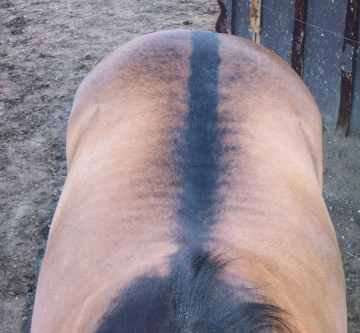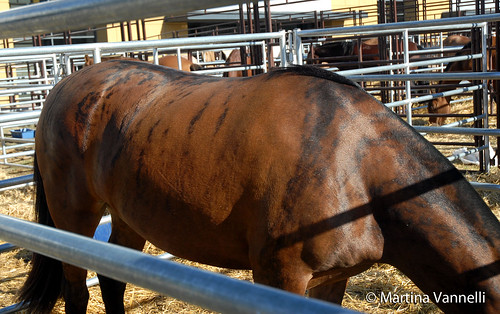Home › Forums › Windstone Editions › General Windstone › This guy could totally be a GB safari unicorn!
- This topic has 7 replies, 1 voice, and was last updated 8 years, 4 months ago by Landipan.
-
AuthorPosts
-
June 23, 2016 at 7:12 pm #948477
I saw this guy on the model horse forums and he makes me think of those striped safari unicorn GBs that Melody has done before! lol

*Formerly meowmix101
Not currently open for PYO commissions.June 23, 2016 at 8:24 pm #949179He’s gorgeous.
June 24, 2016 at 6:59 pm #949182Is he part zebra? – or is that a natural horse marking? I’ve seen Grulla horses with some back stripes, but never one like that!
June 24, 2016 at 7:34 pm #949183Is he part zebra? – or is that a natural horse marking? I’ve seen Grulla horses with some back stripes, but never one like that!
Those are ‘primitive markings’, just abnormally large/noticeable on this cool guy(Who is a Hucul pony I believe), which is found in the Dun gene(Grullas are also part of the dun gene family):
”A primary characteristic of the dun gene is the dorsal stripe, and most duns also have visual leg striping. The shoulder stripes are less common and often fainter, but usually visible on horses with a short summer coat.””
I think I remember seeing a photo of another dun that also had really awesome shoulder stripes a few years ago, but I’ve lot the photo, maybe I can find it again? I’ll post it if I do! (Edit: Now that I think back on it I may be remembering a photo of a brindle horse rather than a dun…)
(edit: this isn’t the one I’m thinking of but it’s similar!)

*Formerly meowmix101
Not currently open for PYO commissions.June 24, 2016 at 7:36 pm #949185Yup, yup, I was mistaken, it was this brindle horse I remembered rather than a dun with intense shoulder bars.

*Formerly meowmix101
Not currently open for PYO commissions.June 24, 2016 at 7:43 pm #949186I don’t think this guy is a ‘true’ dun. There is the specific DUN gene that is tested that causes the primitive markings AND body color dilution. That’s why grullas (who are black with DUN) appear to be different forms of mousy grey. Red duns (chestnut+DUN) are never a dark dark chestnut, always a lighter red with the primitive markings being darker. Dunskins (Buckskin+dun) are always on the lighter side of buckskin as well.
There are a newly discovered genes that they are calling nd1 and nd2. These stand for non-dun 1 and non-dun 2. These genes cause the primitive markings you see, but DO NOT dilute the body color. They have found the nd genes in Arabians, which do not have the DUN gene present in the gene pool. There is now a commercial test for nd1 and nd2 so lots of people have been testing their horses that they SWORE were DUN, but actually only carry nd1 and/or nd2. So, because the guy above does not have any dilution to his body color, I would call nd1 and/or nd2 for that guy. 🙂
(Can you tell I’ve been on the equine color genetics Facebook page too much?)Love baby kirins, safari poads, mini keepers, and anything BLUE, BLUE, and, oh yes, BLUE.
June 24, 2016 at 7:48 pm #949188I don’t think this guy is a ‘true’ dun. There is the specific DUN gene that is tested that causes the primitive markings AND body color dilution. That’s why grullas (who are black with DUN) appear to be different forms of mousy grey. Red duns (chestnut+DUN) are never a dark dark chestnut, always a lighter red with the primitive markings being darker. Dunskins (Buckskin+dun) are always on the lighter side of buckskin as well.
There are a newly discovered genes that they are calling nd1 and nd2. These stand for non-dun 1 and non-dun 2. These genes cause the primitive markings you see, but DO NOT dilute the body color. They have found the nd genes in Arabians, which do not have the DUN gene present in the gene pool. There is now a commercial test for nd1 and nd2 so lots of people have been testing their horses that they SWORE were DUN, but actually only carry nd1 and/or nd2. So, because the guy above does not have any dilution to his body color, I would call nd1 and/or nd2 for that guy. 🙂
(Can you tell I’ve been on the equine color genetics Facebook page too much?)This guy also doesn’t have the leg barring either I noticed, which I thought was kind of strange given how strong the shoulder bars are! Makes since that he may not be a true dun though.
I love how we’re still learning new color genetics all the time! I’d love to buy the Lesli Katheman book on horse color one of these days to learn more about the genetics.
*Formerly meowmix101
Not currently open for PYO commissions.June 25, 2016 at 1:29 am #949197Here’s real life GB tiger safari….a Brindle Criollo

Found here!
*Formerly meowmix101
Not currently open for PYO commissions. -
AuthorPosts
- You must be logged in to reply to this topic.
